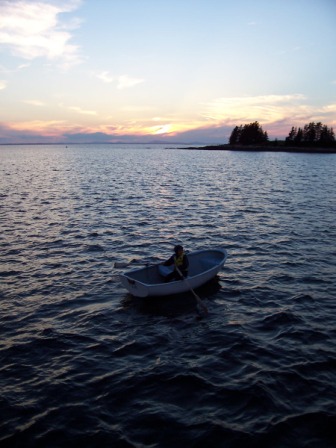Castine Light
Castine, Me.
August 5, 1912
Addressed to
Miss Bernice A-
Agawam, Mass.
.
Castine, Maine. Aug. 5th 1912.
There are two little girls that
now live in this house. They are
about ten and twelve years old. Their
father has been here for a good many years
stationed at a light on an island so
that the girls had never attended school
until last winter. They just love it and do
so much enjoy the winters in this very
quiet little town. It must seem lively
after living on a light house island. We
like it here ourselves. Lovingly,
Aunt Florence
Notes:
I can't help but be intrigued by a time when young boys only went to school in the winter because they were busy working the farm the rest of the year, or when young girls only went to school in the winter because they were living on a lighthouse island the rest of the year!
Castine is an incredibly interesting small town on Penobscot Bay in Maine. It was settled by Europeans before Plymouth; it changed hands and names many times over the following two centuries; it was a significant battleground during the Revolutionary War and saw the battle that earned Paul Revere his court martial. (Which by the way was the worst Naval disaster for America up to Pearl Harbor.) For over 60 years it has been the home of the Maine Maritime Academy. And it has become a vacation and retreat destination for many who think that Winters should be cold and Summers nights should be chilly. (Like me!)
Of course anyone who's spent time driving along the New England Coast (or many other coastlines, for that matter) has seen their share of lighthouses. But aside from being pretty, and having a the most wonderful soulful sound in the fog, what else makes lighthouses so interesting? Here's what Wikipedia has to say about the creation of lighthouses, with an added note from me:
Most of the lighthouses in the United States have been built and maintained by the Coast Guard since 1939, its predecessor the United States Lighthouse Service from 1910-1939 and its predecessor the United States Lighthouse Board from 1852-1910. Before the Lighthouse Board was established, local collectors of customs were responsible for lighthouses under Stephen Pleasonton. (NB, Pleasonton was Department of Treasury.)
If you're interested in great photography and information about the history of lighthouses, you might want to check out the American Lighthouse Foundation's bookstore. This book looks pretty cool:

For a little more information on this particular lighthouse, check out this page, and scroll down to Dice Head Light. Or better still, go directly to this page.
It seems a peculiar thing to raise a family at a lighthouse. I did some web searching to learn more about what that life was like, and found a few good descriptions that might help you understand about the two girls mentioned in the postcard.
First, this account of one family at a lighthouse on Rock Island, Michigan, explains the isolation, how some families chose to live apart, and the concept of "winter break."
The first two Betts children (Wm. Jr. and Jane) were born right at the lighthouse without the assistance of doctor, nurse, or neighbor, the next seven children were born on Washington Island. Records indicate Emily Betts, assistant keeper, and family continued to live at the Lighthouse during the navigational season. It is not clear in which year lighthouse families began living and using Washington Island as their primary residence. Then, children schooled during the year, with families joining the keeper on Rock Island during summer breaks, and the keeper joining his family on Washington Island when shipping stopped at the close of the navigational season - Dec. 15 through April 1.
On Thatcher Island, in Rockport, Massachusetts, they had a teacher on the island for a moment:
There were seven children living at Thacher in the early 1900s. The state refused to build a school on the island, but they finally agreed to pay a teacher to live there. The teacher, a young woman, didn't stay at the island very long. She met and subsequently married Edwin Tarr, son of the keeper and an assistant keeper himself. The couple moved to Boston where Edwin served as keeper of the Long Island Head Lighthouse. After that, most of the children boarded on the mainland during the week so they could attend school.
The kids on Nash Island, in Addison, Maine fared a little better:
For a while, there were enough children living on the island for a small school to be put in operation with a teacher from the mainland. When they reached high school age the children boarded and attended school in Jonesport.I searched and searched but wasn't able to find out who the keeper was at this light in Castine in 1912. But I can imagine the two young girls, going completely and utterly stir-crazy for 7 months out of the year, and then suddenly set free in the "lively" town of Castine. They must have been so grateful just to go to school -- can you imagine?



3 comments:
He,he, you are happy to report that your mom is supporting your habit? Oh, I see...the postcard habit.
Lighthouses are a fun study too. My husband and I stayed at a Lighthouse station on Whitefish Point on Lake Superior, and we have visited other lighthouses on the Great Lake's shores. This summer, we hope to travel to the Outerbanks of North Carolina to visit a few more lighthouses including the Cape Hatteras lighthouse. Thanks for the informative post.
I find lighthouses so beautiful and proud. Oh, those little girls must have lived every moment to the fullest. Thanks for sharing this postcard.
mjd -- yes, I'm now officially addicted to old postcards
hipwritermama -- I agree, lighthouses are beautiful, and interesting!
Post a Comment